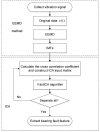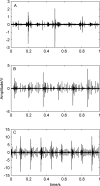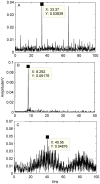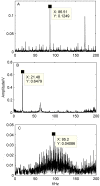A Compound fault diagnosis for rolling bearings method based on blind source separation and ensemble empirical mode decomposition
- PMID: 25289644
- PMCID: PMC4188612
- DOI: 10.1371/journal.pone.0109166
A Compound fault diagnosis for rolling bearings method based on blind source separation and ensemble empirical mode decomposition
Abstract
A Compound fault signal usually contains multiple characteristic signals and strong confusion noise, which makes it difficult to separate week fault signals from them through conventional ways, such as FFT-based envelope detection, wavelet transform or empirical mode decomposition individually. In order to improve the compound faults diagnose of rolling bearings via signals' separation, the present paper proposes a new method to identify compound faults from measured mixed-signals, which is based on ensemble empirical mode decomposition (EEMD) method and independent component analysis (ICA) technique. With the approach, a vibration signal is firstly decomposed into intrinsic mode functions (IMF) by EEMD method to obtain multichannel signals. Then, according to a cross correlation criterion, the corresponding IMF is selected as the input matrix of ICA. Finally, the compound faults can be separated effectively by executing ICA method, which makes the fault features more easily extracted and more clearly identified. Experimental results validate the effectiveness of the proposed method in compound fault separating, which works not only for the outer race defect, but also for the rollers defect and the unbalance fault of the experimental system.
Conflict of interest statement
Figures














References
-
- Hongbin M (1995) Rolling bearing vibration detection and diagnosis. Beijing: Machine Press.
-
- Herault J, Jutten C (1986) Space or time adaptive signal processing by neural network models. Proceedings of the AIP Neural Networks for Computing 151: 206–211.
-
- Friman O, Borga M, Lundberg P, Knutsson H (2002) Exploratory fMRI analysis by autocorrelation maximization. NeuroImage 16: 454–464. - PubMed
-
- Li M, Liu YD, Feng GY, Zhou ZT, Hu DW (2010) OI and fMRI signal separation using both temporal and spatial autocorrelations. IEEE Transactions on biomedical engineering 57: 1917–1925. - PubMed
-
- Lee T, Lewicki MS, Girolami M (1999) Blind source separation of more sources than mixtures using overcomplete representations. IEEE Signal Processing Letters 6: 87–90.
Publication types
MeSH terms
LinkOut - more resources
Full Text Sources
Other Literature Sources
Miscellaneous

